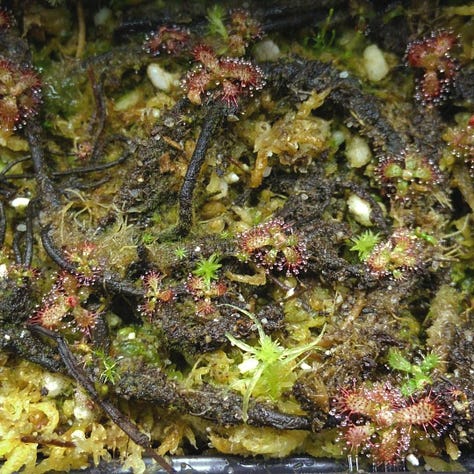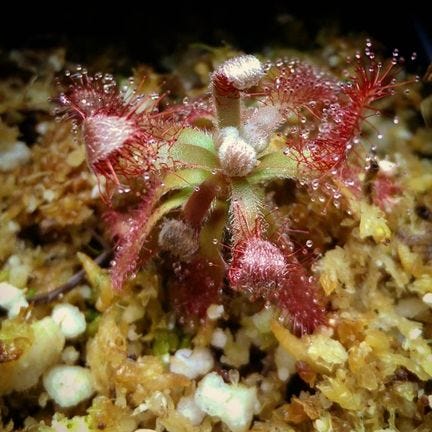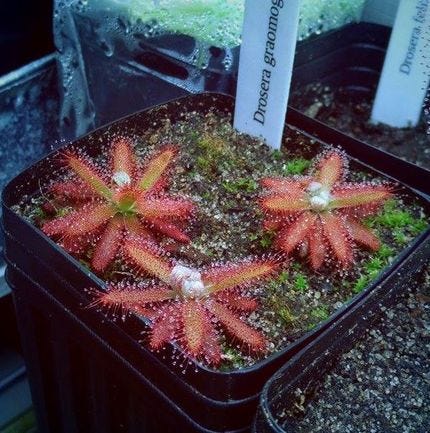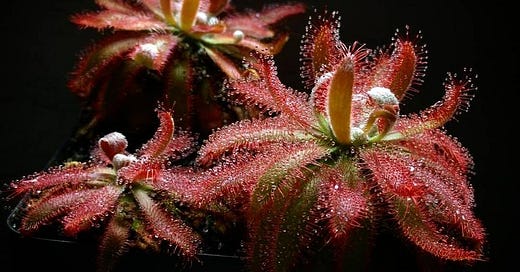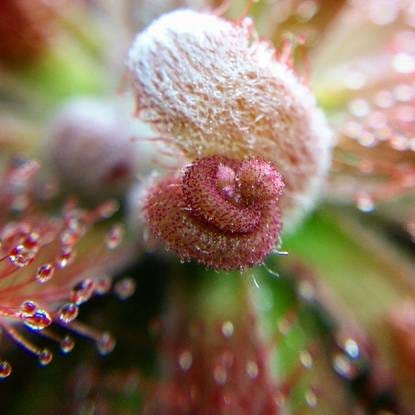SPECIES PROFILE: DROSERA GRAOMOGOLENSIS
This Brazilian sundew is one of the most beautiful in the genus. Best of all, it isn't all that hard to grow.
To me, there are a number of characteristics that make a sundew visually appealing. From beautiful coloration to heavy dew production, many of these characteristics can be found in Drosera graomogolensis, a South American species whose popularity in cultivation has increased dramatically these past few years.
Also, let's get this out of the way: it's typicially pronounced "Gray-oh-moe-goal-en-sis."
A Bit of Background Culture
D. graomogolensis is endemic to the Minas Gerais state in Brazil; its name comes from Grão-Mogol, the municipality where the species was first discovered.
Grão-Mogol is one of a number of locations where D. graomogolensis can be found. All of these locations occur in the campos rupestres habitat (Portuguese for "rocky fields"). This habitat occurs at high elevations (600 to 2,000m) and contains an abundance of shrubby, stunted vegetation. Winters are typically warm and somewhat dry, whereas summers are fairly hot.
Having only been discovered in 1997, D. graomogolensis is not necessarily a recent discovery, but it isn't all that old either. If you're interested in reading the species description, you can find it here.
Light, Temperature, Humidity, and Media
As with other cool-growing South American Drosera, D. graomogolensis demonstrates superior growth with high light, cooler temperatures, and relatively high humidity (> 60% RH). Under these conditions, mature plants will retain dew on well over a dozen leaves at a time and develop striking red coloration. High light really is critical for good growth - without it, the plants will look green, drab, and depressing. The plants are not picky about media as long as it is acidic, water-retentive, and nutrient-free. Peat-based or Sphagnum mixes may work differently for you depending on your conditions but the plants should be able to grow well in both. If you are growing your plant in lower light conditions, I recommend adding more aggregates (perlite, sand, etc.); I have found that D. graomogolensis can be prone to root rot when grown in a dense media with lower light. D. graomogolensis is capable of growing roots upwards of 15" long. While short pots won't necessarily harm the plant, they will cause a buildup of coiled roots at the bottom and, in some cases, can lead to smaller plants. If you do decide to use shorter pots, I recommend not watering via the tray method. I recommend pots no shorter than 5" for mature plants. This species appreciates frequent feeding. As with almost all Drosera, do not apply any fertilizers to the roots.
South American Drosera have a reputation for being very picky. However, not only is D. graomogolensis one of the most beautiful South American species, but it is also one of the most adaptable! Make no mistake—the conditions described above will generally lead to the healthiest and best-looking plants. Adaptability merely means that D. graomogolensis has a wider range of conditions that makes it happy. While most South Americans prefer temperatures in the mid 70s, D. graomogolensis has grown happily for me with 85 degree days. It doesn't even seem to mind! However, it is important to note that you should have a larger temperature drop at night to offset warm daytime temperatures; this plant is certainly tolerant, but it will not be okay with 85 degree temperatures constantly. In regards to humidity adaptability, I have always grown my plants with very high humidity, but I have heard of other growers that have successfully acclimated this plant to windowsill conditions. If you wish to attempt this, I recommend that you grow the plant successfully with high humidity first and then acclimate it very slowly to low humidity.
Flowering and Reproduction
D. graomogolensis is easily propagated vegetatively. I have found that one mature leaf cutting is capable of yielding upwards of six potential plants. In order to propagate D. graomogolensis by leaf cuttings, I snip off a newly grown, healthy leaf with dew on it (this is important) and float it in a petri dish with distilled water. It is important that the petri dish receives a lot of light but does not overheat. Alternatively, I have also placed leaf cuttings directly onto moist sphagnum and have had successful, albeit not as prolific, results. If your leaf cuttings was successful, you should being to see small nub-like plants emerge after several weeks. Allow the individual plants to grow small roots before separating them and planting them in media.
Leaf cuttings certainly work well, but in terms of the sheer numbers of plants produced, I have had the best results from root cuttings. Whenever repotting my plants, I snip approximately half of their roots off. While you'd think that this would make them quite upset, they have never seemed to mind all that much. I then try to rinse as much media off of the freshly harvested roots as I can. Why? In my experience, more plants will sprout if the surface of the root is exposed to light. After washing off the media, I lay the roots across the surface of a long-fiber sphagnum mix (live sphagnum should also work fairly well, so long as it doesn't overgrow the roots). Sometimes I will pin down the root with strands of sphagnum—it is important that it has good contact with the sphagnum surface. Additionally, I highly recommend placing a bag around the entire pot in order to increase humidity. Once the plants have reached a decent size, I will cut the roots to separate them and then pot them individually. Make sure that you bag them, since they will have very undeveloped roots at this time.
D. graomogolensis flowers but is supposedly not self-fertile. Since many of the plants in cultivation are the same clone, this makes it somewhat difficult to get seeds. However, I hypothesize that attempting manual self-pollination might lead to a small fertile seed yield; this was the case for me with a supposedly sterile clone of D. spiralis. Still, D. graomogolensis is easily propagated through vegetative means, so I don't think that its supposed infertility is all that big of a deal.
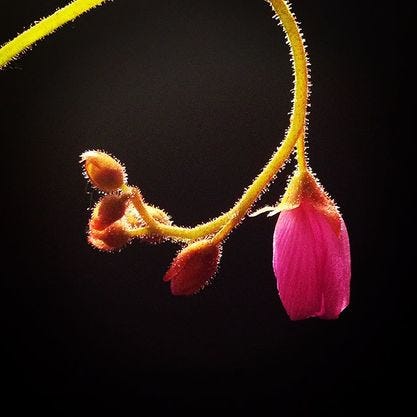
Final Notes
D. graomogolensis is beautiful and, in comparison to other South American Drosera, not all that hard to grow! What's not to love? If you have recently purchased a plant, please note that it can take a few weeks to settle into its new conditions. Don't be worried if it doesn't look all that good at first! I hope this post has been helpful—there are some more photos below.
